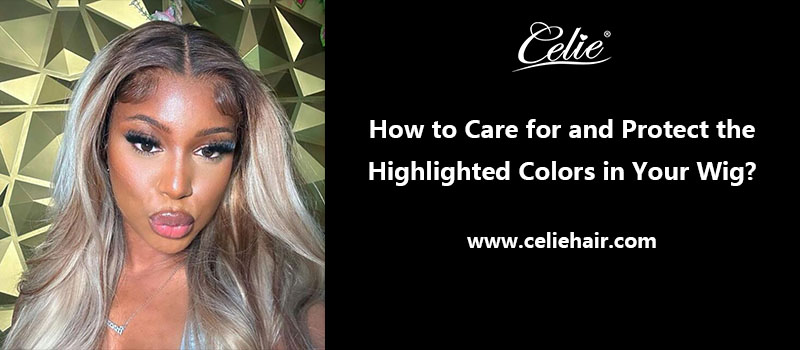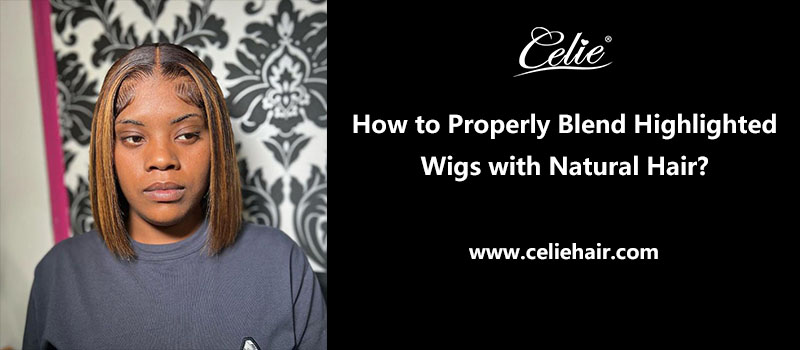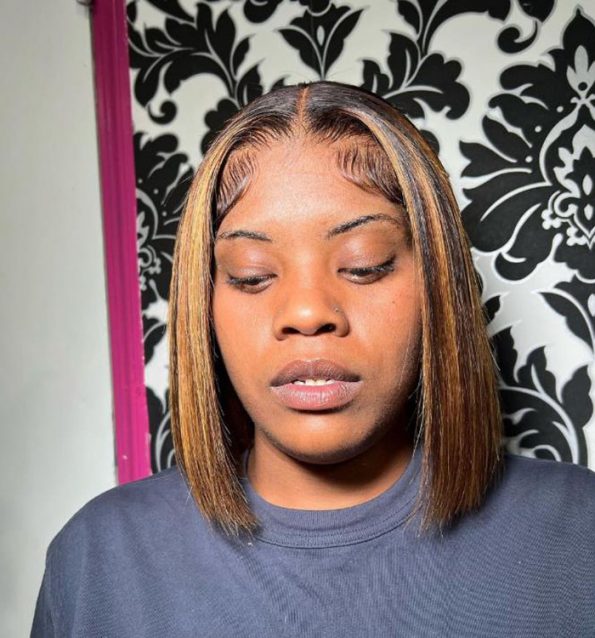One of the most striking wig trends is highlighted colors, which add depth, dimension, and a touch of vibrancy to your hair. Whether you have a natural-looking wig with subtle highlights or a bold and colorful one, taking proper care of those highlights is essential to maintain their beauty and longevity. In this comprehensive guide, we will explore the best practices for caring for and protecting the highlighted colors in your wig.
Introduction to highlighted wigs.
Highlighted wigs have gained immense popularity in recent years due to their ability to mimic the natural beauty of highlighted hair. These wigs typically feature two or more contrasting colors, creating a visually appealing and dynamic look. Some popular highlighted wig styles include ombre, balayage, and chunky highlights, each offering a unique and trendy appearance.
Highlighting wigs can be a fantastic way to experiment with different hair colors without committing to a permanent change. However, to ensure your highlighted wig maintains its allure, you must follow a set of care and protection guidelines.
Understanding wig materials.
Before delving into the specifics of caring for highlighted wigs, it’s important to understand the different materials wigs are made from. Wigs can be crafted from synthetic fibers or natural human hair. The care and protection methods you use may vary depending on the material.
- Synthetic wigs.
Synthetic wigs are typically made from synthetic fibers such as Kanekalon or Toyokalon. These wigs are more affordable than their human hair counterparts and are available in a wide range of colors and styles. However, synthetic wigs can be more prone to damage from heat, friction, and certain styling products.
- Human hair wigs.
Human hair wigs offer a more natural appearance and greater versatility in terms of styling. They are often more durable and heat-resistant than synthetic wigs. When it comes to maintaining the highlighted colors in human hair wigs, many of the same principles apply, but you have more flexibility in terms of heat styling and product use.
Caring for highlighted wigs.
Proper care is crucial for preserving the vibrant colors in your highlighted wig. Here are the steps you should follow to ensure your wig remains in top condition:
- Gentle washing.
Regardless of whether your wig is synthetic or human hair, washing it gently is the first step in maintaining its highlights. Follow these steps for a gentle wash:
- Detangle:Before washing, carefully detangle your wig using a wide-toothed comb or wig brush. Start from the tips and work your way up to the roots to avoid damage.
- Use cold water:Fill a basin with cold water and add a wig-specific shampoo. Avoid hot water as it can strip the color from your wig.
- Soak and swish:Immerse the wig in the soapy water and gently swish it around for a few minutes. Do not rub or scrub vigorously, as this can cause tangling and damage.
- Rinse thoroughly: Empty the basin and refill it with clean, cold water. Rinse the wig until all the shampoo is gone.
- Condition carefully:If your wig is human hair, you can apply a wig conditioner to the ends, avoiding the roots. For synthetic wigs, use a wig detangler or conditioner specifically designed for synthetic hair.
- Rinse again:Rinse the conditioner out with cold water until the wig is residue-free.
- Drying.
How you dry your wig can significantly impact its longevity and color vibrancy:
- Pat dry:Gently blot the wig with a clean, soft towel to remove excess water. Avoid wringing or twisting, as this can distort the wig’s shape and damage the highlights.
- Air dry:Place the wig on a wig stand or a clean, dry towel on a flat surface. Allow it to air dry naturally. Avoid using heat-based drying methods like hairdryers, as excessive heat can fade synthetic wig colors and damage human hair wigs.
- Styling.
When it comes to styling highlighted wigs, it’s essential to use tools and products that are gentle on the colors:
- Heat styling:If your wig is made of human hair, you can use heat styling tools like straighteners, curling irons, and blow dryers on low heat settings. However, always use a heat protectant spray to shield the highlights from excessive heat.
- Synthetic wig styling:For synthetic wigs, avoid using heat styling tools altogether, as they can melt the fibers. Instead, use your fingers or a wig brush to style your synthetic wig.
- Styling products:Opt for wig-specific styling products, such as hairspray, mousse, or gel. These products are formulated to be gentle on wigs and won’t harm the highlighted colors.
- Storage.
Proper storage is essential to prevent tangling and protect your wig’s highlights:
- Wig stand:When you’re not wearing your wig, store it on a wig stand to help maintain its shape and prevent tangling. If you don’t have a wig stand, you can also use a clean, dry towel.
- Cover up:Use a wig cap or a clean, breathable fabric bag to protect your wig from dust and other environmental factors when it’s not in use.
- Avoid sunlight:Store your wig away from direct sunlight, as prolonged exposure to UV rays can cause the colors to fade.
Protecting highlighted colors in synthetic wigs.
Synthetic wigs require some additional precautions to protect their vibrant highlights:
- Avoid heat.
As mentioned earlier, synthetic wigs are not heat-resistant. Avoid exposure to high temperatures, such as those from ovens, stoves, and hot water. Be cautious when opening the oven or standing near a grill, as the intense heat can damage the synthetic fibers and cause the colors to lose their vibrancy.
- Be wary of friction.
Synthetic wigs are also more susceptible to friction damage. To protect the highlights, avoid rubbing the wig against rough surfaces or wearing it under tight-fitting hats or headbands for extended periods.
- Keep away from styling tools.
Never use hot styling tools on synthetic wigs, as the heat can melt the fibers and ruin the colors. If you need to adjust the style of your synthetic wig, use cool water and your fingers to reshape it.
Maintaining highlighted colors in human hair wigs.
Human hair wigs offer more versatility when it comes to styling and heat tolerance, but they still require specific care to preserve their highlighted colors:
- Professional coloring.
If your human hair wig starts to fade or lose its highlights, consider visiting a professional wig stylist who specializes in color treatments. They can help restore the vibrancy of your wig’s colors without causing damage.
- Heat styling with caution.
While human hair wigs can withstand heat styling, it’s crucial to use these tools judiciously to avoid overexposing the highlights. Always use a heat protectant, and avoid using high heat settings unnecessarily.
- Regular conditioning.
Human hair wigs benefit from regular conditioning to keep the hair soft and manageable. Use a high-quality wig conditioner designed for human hair wigs to maintain the integrity of the highlights.
Long-term care and maintenance.
To ensure your highlighted wig remains in excellent condition for the long term, consider the following tips:
- Schedule regular checkups.
If you wear your wig frequently, consider scheduling regular checkups with a professional wig stylist. They can assess the wig’s condition, make any necessary adjustments, and provide expert advice on maintenance.
- Rotate your wigs.
If you have multiple wigs, rotating them can extend their lifespan. This practice prevents excessive wear on a single wig and allows each one to maintain its beauty and color.
- Be mindful of environmental factors.
Environmental factors such as smoke, pollution, and strong odors can affect the quality and scent of your wig. Avoid exposing your wig to environments with these elements whenever possible.
- Know when to retire your wig.
No wig lasts forever, and eventually, the colors may fade, and the fibers may become worn. When you notice significant deterioration, it’s time to consider replacing your wig to maintain a fresh and vibrant look.
Do and Don’t do if you want your highlighted wig have a long service life.
To ensure your highlighted wig has a long service life and retains its vibrant colors, it’s important to follow a set of do’s and don’ts for care and maintenance. Here’s a comprehensive list of what to do and what to avoid:
Do’s for maintaining your highlighted wig:
- Do gentle washing:
Use a wig-specific shampoo and cold water to wash your wig.
Gently swish the wig in the soapy water without rubbing or scrubbing.
Rinse thoroughly with cold water to remove all traces of shampoo.
- Do use wig-specific products:
Opt for products specifically designed for wigs, including shampoos, conditioners, and styling products.
These products are formulated to be gentle on wig materials and colors.
- Do use a wide-toothed comb or wig brush:
Detangle your wig carefully before and after wearing it.
Start from the tips and work your way up to the roots to prevent damage.
- Do air dry:
After washing, gently blot the wig with a soft towel to remove excess water.
Place the wig on a wig stand or a clean, dry towel to air dry naturally.
- Do protect from sunlight:
Store your wig away from direct sunlight and UV rays, as prolonged exposure can cause colors to fade.
- Do store properly:
When not in use, store your wig on a wig stand or a breathable fabric bag to prevent tangling and protect it from dust.
- Do rotate your wigs:
If you have multiple wigs, rotate them to extend their lifespan and reduce wear on any single wig.
- Do schedule professional checkups:
If you wear your wig frequently, consider regular appointments with a professional wig stylist for assessments and maintenance.
Don’ts for maintaining your highlighted wig:
- Don’t use hot water:
Avoid hot water when washing your wig, as it can strip the color from synthetic wigs and may affect human hair wigs as well.
- Don’t use harsh products:
Avoid using regular hair care products, as they may contain harsh chemicals that can damage wig materials and colors.
- Don’t use heat on synthetic wigs:
Never use heat styling tools like straighteners, curling irons, or blow dryers on synthetic wigs, as the heat can melt the fibers and ruin the colors.
- Don’t expose to high temperatures:
Keep synthetic wigs away from sources of heat, such as ovens, stoves, and hot water.
- Don’t rub or scrub vigorously:
Avoid vigorous rubbing or scrubbing when washing your wig, as this can lead to tangling and damage to the highlights.
- Don’t store in tight spaces:
Avoid storing your wig in tight-fitting containers or under hats or headbands that can compress the wig and cause friction damage.
- Don’t overuse styling products:
Limit the use of styling products on your wig, especially if it’s synthetic, as excessive product buildup can affect the colors and appearance.
- Don’t ignore signs of wear and tear:
If you notice significant deterioration, fading, or damage to your wig, consider replacing it to maintain a fresh and vibrant look.
It totally depend on you own.
Highlighted wigs are a fantastic way to experiment with different hair colors and styles, but they require careful care and protection to preserve their beauty and longevity. Whether your wig is made of synthetic fibers or human hair, following the proper care guidelines for washing, drying, styling, and storage is essential.
Remember that synthetic wigs are more sensitive to heat, friction, and styling products, so extra precautions are necessary to protect their highlights. Human hair wigs, while more durable, still require specific care to maintain their color vibrancy.
By following these steps and investing time in the maintenance of your highlighted wig, you can enjoy a stunning and eye-catching hairstyle for many occasions to come. Proper care ensures that your wig continues to turn heads and make you feel confident in your unique style.



